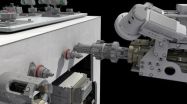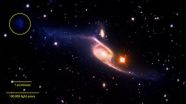(Press-News.org) One of the greatest challenges faced by cancer surgeons is to know exactly which tissue to remove, or not, while the patient is under anesthesia. A team of surgeons and scientists at University of California, San Diego School of Medicine have developed a new technique that will allow surgeons to identify during surgery which lymph nodes are cancerous so that healthy tissue can be saved. The findings will be published in the January 15 print edition of Cancer Research.
"This research is significant because it shows real-time intraoperative detection of cancer metastases in mice," said Quyen T. Nguyen, MD, PhD, associate professor of Head and Neck Surgery at UC San Diego School of Medicine. "In the future, surgeons will be better able to detect and stage cancer that has spread to the patient's lymph nodes using molecules that were designed and developed at UC San Diego."
Lymph nodes, located throughout the body, serve as filters that contain immune cells to fight infection and clean the blood. When cancer cells break away from a tumor, the cells can travel through the lymph system and hide in these tiny organs. Surgeons remove the nodes to determine if a cancer has spread. However, human nodes, only half a centimeter in size, are difficult to discern among the surrounding tissue during surgery. Furthermore, even when surgeons are able to map the location of the nodes, there is no current technique that indicates whether or not the lymph nodes contain cancer, requiring removal of more lymph nodes than necessary.
"With molecular-targeted imaging, surgeons can avoid unnecessary removal of healthy lymph nodes which is better long-term for patients," said Nguyen, director of the facial nerve clinic at UC San Diego Health System. "The range of the surgeon's visual field is greatly enhanced by a molecular tool that can help achieve accurate surgical margins and detection of metastases so that no tumor is left behind."
The fluorescently labeled molecules, known as ratiometric activatable cell-penetrating peptides (RACPP), are injectable. When used in mouse models, surgeons could see where the cancer had spread with high sensitivity and specificity even when the metastatic sites were only a few millimeters in size.
This form of instant pathology is an improvement over traditional sentinel node mapping, whereby only the location of the lymph node is detected without gleaning any information on actual cancer involvement.
Current methods for managing prostate cancer and neck squamous cell carcinoma only reveal the extent of cancer involvement after the patient has undergone surgical removal of all susceptible lymph nodes.
This new technique will decrease OR time because the surgical team need not wait for pathology reports, decrease time under anesthesia, and decrease unnecessary surgery on noncancerous lymph nodes.
Nyguyen's earlier research with Nobel Prize winner Roger Tsien, PhD, professor of pharmacology at UC San Diego School of Medicine, showed in animal models how injectable fluorescent peptides could be used to highlight hard-to-see peripheral nerves, allowing surgeons to avoid them when removing or repairing other tissues.
INFORMATION:
Contributors to this research paper include Elamprakash N. Savariar, Csilla Felsen, Nadia Nashi, Tao Jiang, Lesley G. Ellies, Paul Steinbach, and Roger Tsien from UC San Diego.
This work was supported by the Howard Hughes Medical Institute and ICMIC NCIP50-CA128346 career development grant, the Burroughs Wellcome Fund (CAMS) and NIH grants 5K08EB008122 and R01 CA158448.
Surgical technique spots cancer invasion with fluorescence
2013-01-11
ELSE PRESS RELEASES FROM THIS DATE:
Scripps Florida scientists uncover potential drug target to block cell death in Parkinson's disease
2013-01-11
JUPITER, FL, January 10, 2013 – Oxidative stress is a primary villain in a host of diseases that range from cancer and heart failure to Alzheimer's disease, Amyotrophic Lateral Sclerosis and Parkinson's disease. Now, scientists from the Florida campus of The Scripps Research Institute (TSRI) have found that blocking the interaction of a critical enzyme may counteract the destruction of neurons associated with these neurodegenerative diseases, suggesting a potential new target for drug development.
These findings appear in the January 11, 2013 edition of The Journal of ...
NASA's robotic refueling demo set to jumpstart expanded capabilities in space
2013-01-11
In mid-January, NASA will take the next step in advancing robotic satellite-servicing technologies as it tests the Robotic Refueling Mission, or RRM aboard the International Space Station. The investigation may one day substantially impact the many satellites that deliver products Americans rely upon daily, such as weather reports, cell phones and television news.
During five days of operations, controllers from NASA and the Canadian Space Agency will use the space station's remotely operated Special Purpose Dexterous Manipulator, or Dextre, robot to simulate robotic ...
Study finds poorer outcomes for obese patients treated for lumbar disc herniation
2013-01-11
Rosemont, Ill. – While obese patients are more likely to have surgical treatment for lumbar disc herniation – a slipped or ruptured disc – than nonobese patients, obesity increases operative time, blood loss and length of hospital stay, according to new research published in the January 2013 Journal of Bone and Joint Surgery (JBJS). Overall, obese patients had poorer outcomes with surgical and nonsurgical treatments for lumbar disc herniation than nonobese patients.
The study included 854 nonobese patients with a Body Mass Index (BMI) of less than 30 kg/m², and 336 ...
Virus caught in the act of infecting a cell
2013-01-11
AUSTIN, Texas — The detailed changes in the structure of a virus as it infects an E. coli bacterium have been observed for the first time, report researchers from The University of Texas at Austin and The University of Texas Health Science Center at Houston (UT Health) Medical School this week in Science Express.
To infect a cell, a virus must be able to first find a suitable cell and then eject its genetic material into its host. This robot-like process has been observed in a virus called T7 and visualized by Ian Molineux, professor of biology at The University of Texas ...
Stem cells found to heal damaged artery in lab study
2013-01-11
Scientists at the Texas Biomedical Research Institute have for the first time demonstrated that baboon embryonic stem cells can be programmed to completely restore a severely damaged artery. These early results show promise for eventually developing stem cell therapies to restore human tissues or organs damaged by age or disease.
"We first cultured the stem cells in petri dishes under special conditions to make them differentiate into cells that are the precursors of blood vessels, and we saw that we could get them to form tubular and branching structures, similar to ...
UC Davis study deflates notion that pear-shaped bodies more healthy than apples
2013-01-11
(SACRAMENTO, Calif.) — People who are "apple-shaped" — with fat more concentrated around the abdomen — have long been considered more at risk for conditions such as heart disease and diabetes than those who are "pear-shaped" and carry weight more in the buttocks, hips and thighs.
But new research conducted at UC Davis Health System published in The Journal of Clinical Endocrinology and Metabolism provides further evidence that the protective benefits of having a pear-body shape may be more myth than reality. The journal article posted online January 10 and will appear ...
Oxygen to the core
2013-01-11
LIVERMORE, Calif. -- An international collaboration including researchers from Lawrence Livermore National Laboratory has discovered that the Earth's core formed under more oxidizing condition's than previously proposed.
Through of series of laser-heated diamond anvil cell experiments at high pressure (350,000 to 700,000 atmospheres of pressure) and temperatures (5,120 to 7,460 degrees Fahrenheit), the team demonstrated that the depletion of siderophile (also known as "iron loving") elements can be produced by core formation under more oxidizing conditions than earlier ...
NASA's GALEX reveals the largest-known spiral galaxy
2013-01-11
The spectacular barred spiral galaxy NGC 6872 has ranked among the biggest stellar systems for decades. Now a team of astronomers from the United States, Chile and Brazil has crowned it the largest-known spiral, based on archival data from NASA's Galaxy Evolution Explorer (GALEX) mission, which has since been loaned to the California Institute of Technology, Pasadena
Measuring tip-to-tip across its two outsized spiral arms, NGC 6872 spans more than 522,000 light-years, making it more than five times the size of our Milky Way galaxy.
"Without GALEX's ability to detect ...
Saliva gland test for Parkinson's shows promise, study finds
2013-01-11
PHOENIX — Described as a "big step forward" for research and treatment of Parkinson's disease, new research from Mayo Clinic in Arizona and Banner Sun Health Research Institute suggests that testing a portion of a person's saliva gland may be a way to diagnose the disease. The study was released today and will be presented at the American Academy of Neurology's annual meeting in San Diego in March.
"There is currently no diagnostic test for Parkinson's disease," says study author Charles Adler, M.D., Ph.D., a neurologist with Mayo Clinic in Arizona. "We have previously ...
Inclusion of CTC as HEDIS screening modality could increase colorectal cancer screening compliance
2013-01-11
Availability of CT colonography (CTC), commonly known as virtual colonoscopy, is increasing colorectal cancer (CRC) screening rates across military medical facilities. Inclusion of CTC as a Healthcare Effectiveness Data and Information Set® (HEDIS®)-compliant colorectal cancer (CRC) screening test can potentially raise overall screening rates, according to a study in the January issue of the Journal of the American College of Radiology.
The National Committee for Quality Assurance developed HEDIS to provide quality measures for the evaluation of standards of medical ...




